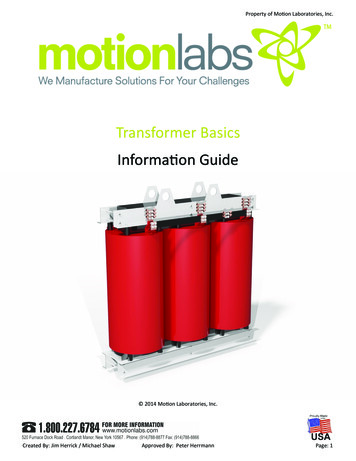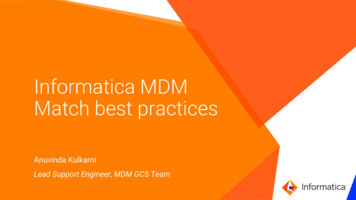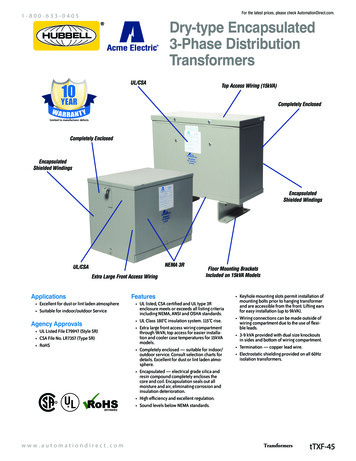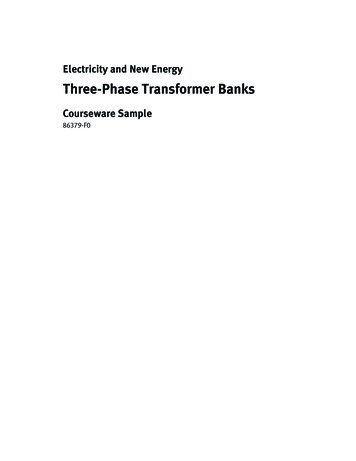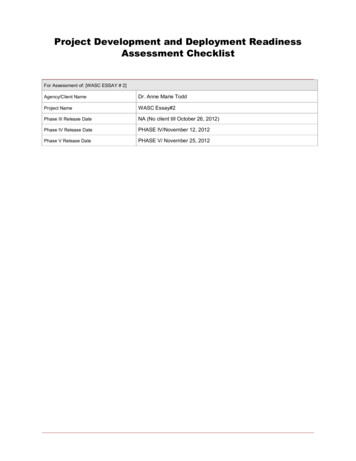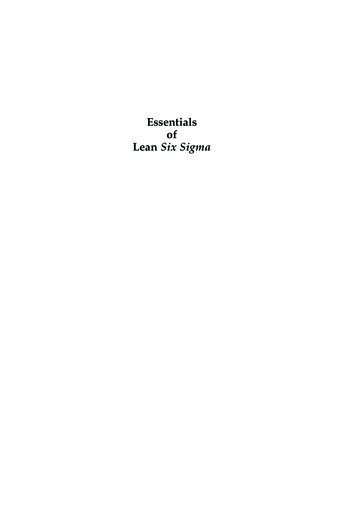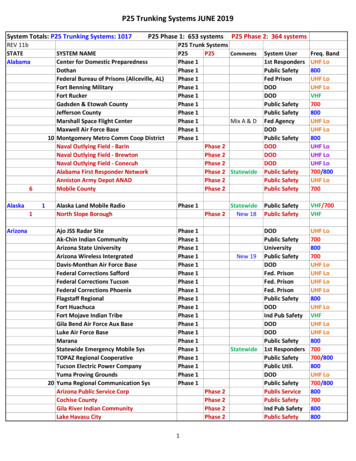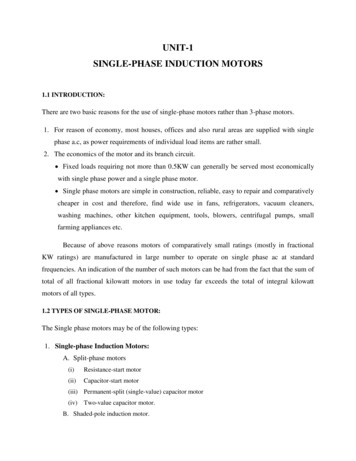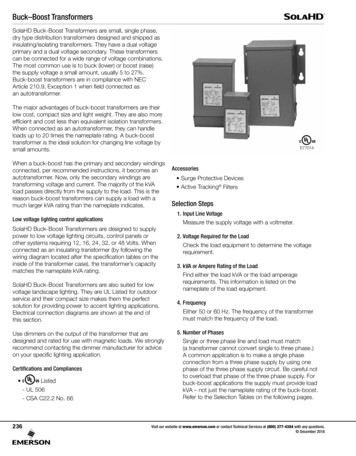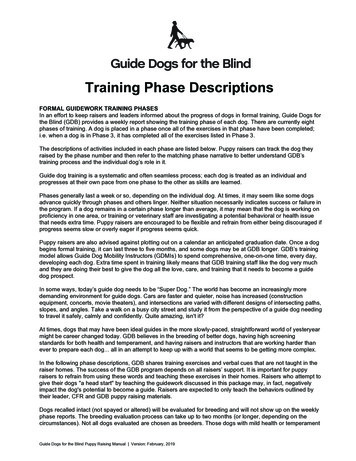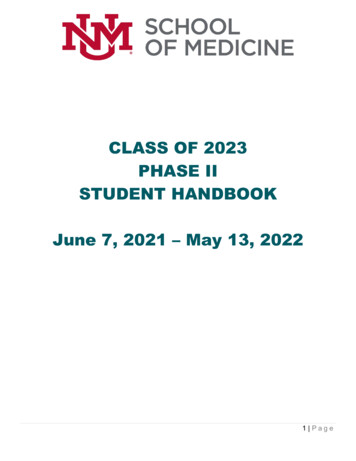
Transcription
CLASS OF 2023PHASE IISTUDENT HANDBOOKJune 7, 2021 – May 13, 20221 Page
Table of ContentsClerkship Directors and Coordinators . 4Administration & Resources . 5Phase II Clerkships – General Information . 6Phase II Goals . 6Call/After Hours Responsibilities . 7Work Hours . 8Time Away from Clerkship. 8Holidays. 8Inclement weather . 8Student Pagers vs. Cell Phones vs. TigerConnect . 8Social Media . 9Background Check and Medical Student Drug Testing . 9Miscellaneous Information . 9Scrubs . 9Dress Code . 10Safety . 10Write-Ups (SOAP Notes, Operative Notes, Admission H&Ps) . 11Phase II Clerkship Performance Objectives . 13Academic Support. 14Office of Assessment & Learning (A&L). 15Phase II Clerkships / Assessment . 15Assignment of FINAL Clerkship Grades . 15Components of the Final Clerkship Grade. 16Standards for Other Grading Policies . 17Other Information on Grading . 18Grade Change Policy . 18Academic Disputes. 18Phase II Grading Policies / Professionalism. 19Examples of Professionalism Lapses . 19Process for Reporting Professionalism Concerns in Phase II . 20Phase II Absence Policies. 20Phase II Clinical Performance Examinations . 24Observed Structured Clinical Exam . 24Teaching Sessions in Phase II . 27Family & Community Medicine . 272 Page
Internal Medicine . 27Neurology . 27Obstetrics & Gynecology . 27Pediatrics. 27Psychiatry . 27Surgery . 27Phase II Learning Communities (LC) . 28Doctoring 3: Honing your Skills & Cultivating Resilience in Clinical Practice . 29Class of 2023 Learning Communities, Doctoring 3, and Class Meetings Schedule . 33Specialty Exploration Experience (SEE) . 35Family & Community Medicine Phase II Clerkship. 37Internal Medicine Phase II Clerkship. 38Neurology Phase II Clerkship. 41Obstetrics & Gynecology Phase II Clerkship. 42Pediatrics Phase II Clerkship . 44Psychiatry Phase II Clerkship . 45Surgery Phase II Clerkship . 46Survival Tips for Phase II Clerkships . 47APPENDIX A: Student Notes in the Patient’s Medical Record . 48APPENDIX B: UNM SOM Clerkship Performance Objectives . 49APPENDIX C: Completion of Online Phase II Clerkship Evaluations . 52APPENDIX D: Anonymity of Students’ Online Evaluations of Phase II Clerkships . 53APPENDIX E: Universal Clerkship Objectives . 54APPENDIX F: Clerkship Objectives . 55APPENDIX G: Information for Parents. 59APPENDIX H: Preceptor Evaluation of Medical Student Clinical Performance. 603 Page
Clerkship Directors and CoordinatorsFamily and Community MedicineClerkship DirectorAssistant Clerkship DirectorClerkship CoordinatorElena Bissell, MDBrian Solan, MDNicole duHSC-FMClerkship@salud.unm.eduInternal MedicineClerkship DirectorAssociate Clerkship DirectorAssistant Clerkship DirectorAssistant Clerkship DirectorPatrick Rendon, MDMary Lacy, MDBlavir Rukov, MDRebecca Richardson, ff@salud.unm.eduNeurologyClerkship DirectorAssociate Clerkship DirectorClerkship CoordinatorTarun Girotra, MDClotilde Hainline, MDAlexis z@salud.unm.eduMaria Montoya, MDSalam Chalouhi, MDEmily alud.unm.eduChandler Todd, MDAlison Campbell, MDSoha Shah, MDElizabeth diatricClerkship@salud.unm.eduDeborah Dellmore, MDEmiliano Valles, MDCaitlin Armijo, MDSamantha 72-5416Obstetrics & GynecologyClerkship DirectorClerkship DirectorClerkship CoordinatorPediatricsClerkship DirectorAssistant Clerkship DirectorAssistant Clerkship DirectorClerkship CoordinatorPsychiatryClerkship DirectorAssociate Clerkship DirectorAssistant Clerkship DirectorClerkship duSurgeryClerkship DirectorAssistant Clerkship DirectorAssistant Clerkship DirectorAssistant Clerkship DirectorClerkship CoordinatorClerkship WebsiteBradley Pickett, MDRachel Danczyk, MD505-934-5900BPickett@salud.unm.edu505-453-8411 (c)Rachel.Danczyk@va.gov505-265-1711(ext. 3136)Brandon Behrens, MD319-830-7620BBehrens@salud.unm.eduRenee Pepin, MD505-925-7671RPepin@salud.unm.eduDaniel y.unm.edu/education/clerkship/index.htmlDoctoring 3Doctoring 3 Course DirectorEsmé Finlay, MDEFinlay@salud.unm.eduSpecialty Exploration ExperienceSEE Preceptorship Director:Education Support Coordinator:Erin Bouquin, MDAntoinette edu4 Page
Administration & ResourcesOffice of Assessment & Learning (A&L)Executive DirectorAssistant DirectorOperations ManagerData Services ManagerData AnalystOffice Phone: 505-272-8028Jacob Imber, MDJImber@salud.unm.eduBradley Pickett, MDBPickett@salud.unm.eduKristy AlloccaKAllocca@salud.unm.eduJ. Allen VeitchJAVeitch@salud.unm.eduJohn -of-medicine/education/md/ume/al.htmlOffice of Medical Student AffairsAssociate Dean of Medical StudentsAssistant Dean of Medical StudentsOffice Phone: 505-272-3414Sheila Hickey, MDSHickey@salud.unm.eduTeresa Vigil, f-medicine/education/md/omsa/index.htmlOffice of Undergraduate Medical EducationInterim Associate Dean of UMEAssistant Dean of Clinical EducationAssistant Dean of Foundational SciencesOffice Phone: 505-272-4823Edward Fancovic, MDEFancovic@salud.unm.eduRebecca Hartley, l-of-medicine/education/md/ume/index.htmlApplied Cognition in the Medical Sciences ProgramDirectorLearning SpecialistOffice Phone: 505-925-4441Tom Markle, PhDDTMarkle@salud.unm.eduAlyssa p.htmlOffice of Professional Well-BeingAssistant Dean of Professional ctor, UME Wellness InitiativesLiz Lawrence, MDRaven Cuellar, PhDJeff Dunn, MDRebecca Ezechukwu, PhDJoyce Phillips, lips@salud.unm.eduOPW@salud.unm.eduLearning Environment OfficeOffice Phone: 505.272.7867Report MistreatmentRecognize an exemplary Teacher orLearning d62d66ce50348Office of Program Evaluation, Education, and Research (PEAR)DirectorHSC Associate Scientist IIIHSC Associate Scientist IIOffice Phone: 505-272-8069Rebecca Hartley, PhDRHartley@salud.unm.eduNancy Shane, PhDNLShane@salud.unm.eduRoger Jerabek, -of-medicine/education/md/ume/pear.html5 Page
Phase II Clerkships – General InformationPhase II begins on June 7, 2021 and ends on May 13, 2022. There are seven 6-week clinical rotationsand scheduled vacations: 5/29-6/6/21, 9/4-9/12/21, 11/20-11/28/21, 12/18/21-1/2/22, and 3/31-4/3/22.There are seven required Phase II Clerkships: Family Medicine, Internal Medicine, Neurology,Obstetrics & Gynecology, Pediatrics, Psychiatry, and Surgery. Phase II Clinical Clerkships are sixweeks in length with the exceptions of Neurology and Psychiatry, which are four weeks each; youwill complete the Specialty Exploration Experience during your Neurology and Psychiatry rotations.Phase II GoalsPhase II has been designed to provide supervised clinical experiences and teaching sessions tosupport each medical student in meeting the University of New Mexico (UNM SOM) ProgramCompetencies and Objectives; to be successful at passing Step 2 CK; and to acquire the knowledge,skills, and attitudes necessary for residency.Each of the seven Clerkships and the Doctoring course will provide educational experiences tosupport learning in these important contexts:1. patient care2. teamwork3. professional identity formationPatient care - Requires flexibility across various settings (clinical skills performance, communicationskills, professionalism) - all Clerkships, DoctoringLearning to work well as a part of the health care team - with physicians/residents/peers and withinter-professional team members (Clerkships)Developing yourself as a physician - Who do you want to be as a physician? How do you want topractice? How do you maintain wellness in this environment? (Clerkships, Doctoring)Assessment occurs in:1. the students’ clinical environment (clinical performance rubric–PRIME) and in clerkshipspecific testing;2. NBME subject exams (knowledge and clinical reasoning assessment and to prepare for Step2);3. and on OSCEs (an evaluation of clinical skills, communication skills, and clinical reasoningskills best practices in a standardized clinical setting)Overall, the content of Phase II will help students prepare for Step 2 CK and to choose a specialty.6 Page
Call/After Hours ResponsibilitiesFamily & Community Medicine: No overnight call.Internal Medicine: No overnight call.At the VA and UNMH, teams are on call every 4th day and students leave at before 10 PM.The day call and MICU transfer are days for student to complete histories and physicals.Neurology: No overnight call. Students will take one weekday short call at UNMH from 4pm to 8pm during the four-weekrotation.Obstetrics & Gynecology: No overnight call. Each student is assigned a week of night float on Labor & Delivery On L&D, students will be scheduled for a weekend day and a weekend night. During orientation, oral exams, shelf exams, OSCE’s or mandatory SOM meetings, some variability may occur.For all rotations, rounding in the early a.m. is expected one weekend day per week and onholidays.Pediatrics: Inpatient Day Team: 6 am - 6 pmInpatient Night Team: 12 noon to midnightHeme/Onc Team: 6 am – 6 pmPediatric Outpatient Clinic: 8 am – 5 pm shiftsNewborn Nursery: 7 am to 6 pmPediatric ED: 7am-3pm shifts and 3pm-11pm shiftsFor all sites, clinical duties may include one weekend day per week and holidays.Psychiatry: No overnight call.Students will experience emergency psychiatry on night shifts during the 4-week block. Theywill do the shifts in the Psychiatric Emergency Service (PES) at the Mental Health Center.Surgery: You may be expected to work one weekend day per week.7 Page
Work HoursThere is a maximum work hour limit for students, not to exceed 80 hours per week. Most clerkshipsprovide for one day off every seven days, while other clerkships schedule hours such that averagedover a four-week period, a student will have four days off. For each rotation, students on eachclerkship will be asked to track their work hours for two weeks out of every month to verify thateach clerkship maintains and adheres to this policy (See Student dent-promotion-and-policies.htmlTime Away from ClerkshipFor information regarding other time off during the clerkship (e.g. sick leave, conferences, personal/family emergencies, personal events, exams, etc.) – please refer to the leave policy on the student-promotion-and-policies.html#tab-2Absences away from clerkships will be tracked over the course of Phase II.HolidaysWhether or not a Phase II student will be off for a holiday (e.g. Independence Day, Labor Day,Thanksgiving, Martin Luther King Jr. Day, Memorial Day) varies with the clerkship and site. In general,students should assume that they ARE working the holiday unless they are otherwise notified bythe Clerkship Director.Inclement weatherSee the “Inclement Weather Policy” in the policies section of the OMSA ent-promotion-and-policies.html#tab-3Student Pagers vs. Cell Phones vs. TigerConnectAll students are asked to use TigerConnect, a safe, secure way to send and receive messages.(Students should contact OMSA if they need to set up the TigerConnect system on their devices.)1. DOWNLOAD THE TIGERCONNECT APPNavigate to the App Store on iPhone or Play Store on Android and search for ‘TigerConnect’.Download and install it.2. LOGINIn the TigerConnect app on your phone, log in with your email address @salud.unm.edu andyour HSCNetID Password.(This is the password you use to login to your work computer and email)3. SEND YOUR FIRST MESSAGETap on 'Directory' and use the search bar to find someone.Send them a text to say “hello!”Additionally, Clerkship Directors may ask students to provide either a cell phone number or a pagernumber. If the students choose to have a cell phone only for a contact, they must: Give the Office of Medical Student Affairs the number so all Clerkship Coordinators have itreadily available before the start of the rotation. Consider their own privacy issues. Be certain there is good reception in the hospital to ensure the reliability of the cell phonenumber. Understand that while on the Trauma Service in the Surgery Clerkship, they will likely be givena pager to use.8 Page
Social MediaThe University of New Mexico School of Medicine (UNM SOM), recognizes that social media siteslike Facebook, Twitter, YouTube, and Instagram have become important and influentialcommunication channels for our community. To assist in posting content and managing these sites,UNM SOM has developed policies and guidelines for use of social media. For details, see policies onthe OMSA ent-promotion-and-policies.html#tab-3Background Check and Medical Student Drug TestingA critical part of medical education involves learning experiences in hospitals and other health carefacilities. Use of these facilities for training is essential and students must be able to complete theirassigned rotations. Most of these hospitals and health care facilities have policies requiring drugtesting and/or criminal background checks. UNM medical students are required to complete andpass a yearly background check and drug screen. Students must to comply with all facility policiesand state law, which include the aforementioned drug testing and background checks. Anyquestions or concerns regarding this may be shared confidentially with the Office of Medical StudentAffairs.Miscellaneous InformationLockers, located in the Barbara and Bill Richardson Pavilion (BBRP), are available to students on afirst-come, first-serve basis. There are no lockers available to you at the VA Hospital. Students areinstructed to come to the Office of Medical Student Affairs to get a UNM Hospital lockercombination and a card with important Phase II phone numbers.Scrubs To obtain access to the UNMH Scrub Machines, students must first retrieve their 8-digit scrubcode from one of the ScrubEx scrub machines. There are two scrub machines on the 2ndfloor of the Main side of the hospital by the ACC area. The third is on the 5th floor of theBBRP side of the hospital by the service elevators. To retrieve your 8-digit scrub code, scanyour badge at the machine and write down or take a photo of the number. Students will thentake their 8-digit scrub code to the Linen Department (far northeast corner of Main Hospitalon the 2nd floor). The Linen Department will enter the student in the system and issue theirinitial set of scrubs.If a student needs OR scrubs (OR scrubs are now purple), they must complete an OR ScrubRequest Form and bring the form to the Linen Department along with their 8-digit scrubcode. Students can request the OR Scrub Request Form by emailing those in charge of scruballocation directly at OR-Scrubs@salud.unm.edu. (If a student has already been entered inthe system and needs OR scrub access at a later time, they can return the form via email toOR-Scrubs@salud.unm.edu in lieu of visiting the Linen Department in person). MedicalStudents are issued 2 scrub credits (can be a combination of purple and green scrubs).Medical students can change into surgical scrubs in the main OR locker room. Scrubs can bereturned to any ScrubEx machine; however, you can only get purple scrubs from the MainOR ScrubEx or Peds OR ScrubEx.Please keep in mind:o When returning scrubs, there is a 30 second window so please make sure you areready to return a full pair (1 top & 1 bottom).o Please check pockets before returning scrubs.o Scrubs are not to leave the hospital as they are hospital property.Badges should always be worn in patient care areas.9 Page
Dress CodeProfessional appearance: Students are encouraged to place a high value on grooming and personalhygiene. See UNMH Policies, Procedures, and Guidelines: Dress Code Policy for details. Briefly, thefollowing guidelines apply to students: UNMH ID badge worn at all times and must be displayed above the waist line at all timeswhile on duty. Extraneous pins or decals are not to be placed on the front of the badge.Neither the name nor the photo on the badge is to be obscured. Good personal hygiene is required, including bathing and grooming. Clothing must be neat, clean, wrinkle-free, and in good repair. Highly fragranced lotion, perfume, cologne and/or smoke odor must be avoided. Hair must be worn in a professional manner and in a way that prevents contamination anddoes not present a safety hazard. Mustaches and beards must be well groomed. Facial hair cannot interfere with seals on masks. Jewelry must be kept to a minimum. Piercings are permitted, but excess piercings may have to be removed if deemedunprofessional. Piercings may not have loops of any kind (only studs are permitted), exceptloop earrings are permitted in areas not providing direct patient care. Gauges may be wornif they are no larger than 1¼ inches (32 mm). No open toe shoes. Clothing should be clean and in good repair. If you wear a white coat, it should be clean. If scrubs are allowed on your service (check with the clerkship) students should wear a cleanwhite coat over the scrubs. No shoe covers, hats, dirty scrubs (blood or other body fluids,etc.) should be worn outside the operating room. In general scrubs are allowed only for theOR, call, and during patient care activities on select clerkships. Purple scrubs are for use only in the OR. Please dress in business casual at a minimum when attending clerkship activities that donot require patient contact (e.g. orientation, grand rounds, and lectures).Safety Personal safety – security escorts are readily available for walking you to your car at night(e.g. going home after being on call or working evening hours).o https://campussafety.unm.edu/ OR http://loboguardian.unm.edu/Possessions – keep valuables on your person or locked in your locker.Blood and body fluid exposures, needle stick injuries.o Please see the “Blood and Body Fluid Exposure” section on UNM’s Student Health andCounseling Center site http://shac.unm.edu/bbp.htm for procedures on how to beevaluated in the event of an exposure.10 P a g e
Write-Ups (SOAP Notes, Operative Notes, Admission H&Ps)Medical student documentation (clinic notes, admission H&Ps, inpatient progress notes, operativenotes, post-op notes, discharge notes, etc.) will be placed in the patient’s electronic medical record.Student documentation will vary from one clerkship to another and from one institution to another.Each clerkship director will explain individual block expectations during each clerkship orientation.Medical students may gather preliminary information (pre-rounding) independently. However, anyinformation gathered and documented by the student which contributes to the billable E/M servicemust also be verified with patient/family in the presence of a resident or attending physician. Theexceptions to this are the Review of Systems (ROS) and Past, Family, and Social Histories for whichindependent documentation by the medical student is still allowed.You will be able to practice order entry in the EMR and the orders will be co-signed by yoursupervisor.Some guidelines about writing notes are as follows: Unless otherwise specified, a student should expect to write a complete SOAP note oradmission H&P on each patient they see. Depending on the rotation, you will enter a note,and forward it to your supervisor for review, feedback, and signature, but this procedurevaries for each clerkship. Phase II medical students are NOT allowed to dictate any patient clinical note. Phase II students are NOT allowed to be scribes for the intern, resident, fellow, orattending. All written documentation must be credited to the original author.o Students need to tag information to cite a footnote included in their note.o Residents and Attendings may not cut/copy/paste a note written by a student withouta UNM-specific attestation. The student’s name and signature must be included at theend of the note.o A student’s contribution to care needs to be documented. It is not acceptable forstudents to scribe under someone else’s login. Student work needs to be signed bythe student.o The note type used by the service should be used if student will be the first author ofthe official documentation in the electronic medical record. While on the OB/GYN** or Surgery Clerkships:o **Students on the OB/GYN Clerkship can document on ALL admitted patients andthose seen in clinic. (The HPI and PE must be repeated by the resident/attending.)Additionally, students CANNOT document any CPT billing (i.e. UPTs, NST, procedures,ultrasounds, etc.) Students cannot document on any critically ill patients.o All outpatient notes (NOT pre-ops or post-ops) are dictated by an attending orresident.o Inpatient notes that are related to surgery are written and co-signed by a resident.Since the billing for surgery and deliveries are global (i.e., one charge for the entireadmission – surgery and post-op days) students may write the notes and residents donot need to completely re-write them.o Selected outpatient notes are written by the students with an attached note by theresident / faculty. There are national regulations developed because of fraudulentbilling by physicians who were not physically present at the time of the service forclinical notes recorded in a patient’s medical record by medical students and residents.UNM SOM follows these regulations. CMS Statement:11 P a g e
oAny contribution and participation of a student to the performance of a billable service(other than review of systems and/or past family/social history which are notseparately billable but are taken as part of an E/M service) must be performed in thephysical presence of a teaching physician or the physical presence of a resident in aservice that meets the requirements in this section for teaching physician billing.Students may document services in the medical record; however, the of the E/Mservice being billed and may verify any student documentation of them teachingphysician must verify in the medical record all student documentation or findings,including history, physical exam, and/or medical decision making. The teachingphysician must personally perform (or re-perform) the physical exam and medicaldecision-making activities in the medical record rather than re-documenting this work.12 P a g e
Phase II Clerkship Performance ObjectivesIn 2005, the Clerkship Directors developed the document “Phase II Clerkship PerformanceObjectives” (See Appendix B). This list of common presenting complaints and procedural andcommunication skills is reviewed and updated annually and was extensively reorganized in 2016.For each presenting patient complaint, you should be able to obtain an accurate medical history, toperform a focused physical exam, and to accurately interpret
Family and Community Medicine Clerkship Director Elena Bissell, MD 505-264-3047 EBissell@salud.unm.edu Assistant Clerkship Director Brian Solan, MD 505-980-7081 BSolan@salud.unm.edu Clerkship Coordinator Nicole Baca 505-272-6607 NkBaca@salud.unm.edu HSC-FMClerkship@salud.
